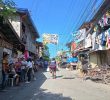Erosion of the domestic economy
Seeming improvements in various external indicators are also hyped as signs of an improving economy. The �resurgent� peso which hit a near 6-year high of P49.19 to the US dollar in late December is particularly hyped as a sign of strength. Yet, on the contrary, most of the factors underlying the recent appreciation of the peso in fact highlight the opposite (aside from the actual weakening of the US dollar because of the U.S.�s internal economic problems). The peso has not been appreciating because of increasing global demand for genuinely Philippine-made goods. If it were the case, it would have been a good thing insofar as that would imply increased domestic production for the international market. The gains from the increased production of local firms would supposedly accrue to the domestic economy and its producers.
However the appreciation of the peso has instead been driven by factors with little relationship to building domestic productive capacity. The country�s biggest source of foreign exchange is remittances from some nine million overseas Filipino workers (OFWs) driven to seek work abroad. OFWs sent back US$10.3 billion in the first ten months of 2006, or a 16.6 percent increase from the same period the year before. OFW remittances benefit the economy in two ways. The accumulation of foreign exchange brought about by the remittances eases local demand for dollars causing its value to go down. Second, it supports the consumption and survival of tens of millions of OFW family members left behind. But in a deeper economic sense the cheaply bought labor of OFWs actually contributes more to building the economies of their host countries than of the Philippines. Moreover, the increasing deployment of OFWs is actually an indication that the local economy � eroded by decades of retrogressive �free market� policies � is bereft of opportunities for productive employment, which is the reason OFWs went abroad in the first place.
The country�s other sources of foreign exchange are not only much less but also basically hollow in their own specific ways. Exports in the first ten months of 2006 grew 16.4 percent from a year ago to US$39.3 billion. But over four-fifths of these exports are heavily import-intensive electronics (some 75 percent), clothing and a few other manufactures, mainly by foreign TNCs. Because the country�s export products are heavy on imported components, not to mention the imported machines and oil needed to produce these, net foreign exchange earned from exports is much less and even smaller than that coming from OFW remittances. There were also net portfolio investments in the first eleven months of the year of US$2.1 billion, marginally higher than in the same period last year. Portfolio investments are highly mobile and do not actually contribute to the economy except as temporary sources of foreign exchange.
Surrendering economic sovereignty
The country�s economic problems are essentially the result of decades of anti-people and elite-oriented economic policies. The so-called neoliberal �globalization� policies that surrender economies to the profit-oriented dynamic of foreign monopoly capital and domestic big business are trade and investment liberalization, privatization and deregulation.
Pres. Gloria Macapagal-Arroyo has been a dogmatic advocate of �free market� policies since her technocratic days in the 1980s, her senatorial stint in the 1990s and up to her presidency in the 2000s. In 2006 she took these policies as far as possible within the current Constitution and, deeming this the last remaining legal fetter, also pushed to change the charter itself.
There was the renewed drive to open up the country�s rich mineral resources to foreign plunder. Building on various mining-related plans and programs and a favorable Supreme Court decision in 2004 and 2005, the government held international mining conferences and went on an international road show in 2006. Within the Association of Southeast Asian Nations (ASEAN) the Philippines pushed for so-called �regional integration� � deceitful spin for economic policies geared at attracting American, European and Japanese investors away from China and India by offering cheaper labor, greater freedom to exploit natural resources, lower environmental standards, lower taxes, and as unrestricted operations as possible.
2006: Davao Today's Year-End Series









